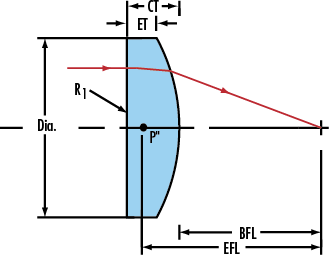
 TECHSPEC® 부품은 에드몬드 옵틱스가 설계, 사양 지정 및 제조하는 제품입니다. 더 알아보기
TECHSPEC® 부품은 에드몬드 옵틱스가 설계, 사양 지정 및 제조하는 제품입니다. 더 알아보기
| 가격(부가세 별도/Tax excluded) | |
|---|---|
| 수량 1-5 | KRW 373,375 개당 |
| 수량 6-25 | KRW 325,583 개당 |
| 수량 26-49 | KRW 294,271 개당 |
| 더 필요하신가요? | 견적 요청 |
Unlike traditional focusing lenses, these lenses should be used with the plano side facing the light source.
해당 제품은 TECHSPEC® PCX Lens를 개조한 제품으로 특정 파장 대역에서 우수한 성능을 제공하기 위해 부드러운 비구면 표면을 갖습니다. 기존의 구면 렌즈와 달리 설계 파장에서 회절 한계 스폿 크기를 생성하므로 빛의 초점을 맞추거나 시준하는 어플리케이션에 적합합니다. 에드몬드옵틱스의 모든 표준 렌즈는 해당 제품과 유사하게 개조가 가능하며 합리적인 가격으로 적합한 표면을 만들어 성능 향상은 물론 특정 어플리케이션 요건에 맞는 최상의 솔루션을 제공합니다.
참고: 기존의 초점 렌즈와 달리 평평한 쪽이 광원을 향하게 하여 사용해야 합니다.

에드몬드옵틱스는 특정 어플리케이션 요건을 충족할 수 있는 광학 및 이미징 부품에 대한 포괄적인 맞춤형 제조 서비스를 제공합니다. 에드몬드옵틱스는 프로토타입 개발, 본격적인 생산 준비 단계 등 단계와 관계없이 고객의 니즈를 충족하는 유연한 솔루션을 제공합니다. 에드몬드옵틱스의 엔지니어는 전 개발 과정을 지원합니다.
에드몬드옵틱스의 제조 역량:
자세한 내용은 에드몬드옵틱스의 맞춤형 제조 역량 페이지를 확인하거나 여기로 문의 바랍니다.
본사 및 지사별 연락처 확인하기
견적 요청 도구
재고 번호 입력 필요
Copyright 2023, 에드몬드옵틱스코리아 사업자 등록번호: 110-81-74657 | 대표이사: 앙텍하우 | 통신판매업 신고번호: 제 2022-서울마포-0965호, 서울특별시 마포구 월드컵북로 21, 7층 (서교동, 풍성빌딩)
The FUTURE Depends On Optics®